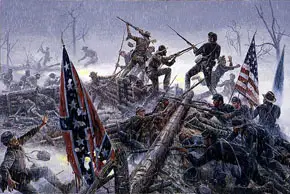Link To This Page — Contact Us —
The Battle of Drewry's Bluff/Fort Darling (Second)
May 12-16, 1864 in Chesterfield County, Virginia
Bermuda Hundred Campaign
BATTLE SUMMARY
The Union landing at Bermuda Hundred on May 5th seriously threatened both Richmond and Petersburg. Confederate authorities, facing the numerically superior Union Army of the James, rushed reinforcements to the crucial railroad center of Petersburg. The former Massachusetts politician, Maj. Gen. Benjamin F. Butler, commanding the Federals, lacked ability and initiative. for 5 days, Butler catiously lumbered across the peninsula between the James and the Appomattox rivers. Repulsed at Swift Creek on the 9th, Butler withdrew to a defensive position across the Bermuda Neck.Butler's retreat behind his newly constructed works enabled Gen. P.G.T. Beauregard to assume the offensive. With 18,000 troops, he hoped to lure Butler's 39,000-man army from behind their strong line. Beauregard sent 7 brigades under Maj. Gen. Robert F. Hoke to Drewry's Bluff, the Confederate works overlooking the James River, 5 miles below Richmond.
Butler complied on the 12th, advancing northward toward Hoke. Leaving behind 2 infantry divisions and sending his cavalry on a raid against the railroads, Butler marched with 15,000 infantry of the XVIII and X Corps. Butler had decided to threaten the Confederate capital.
By the morning of the 13th, the Federals had pushed the Confederates from their outer works into the main line at Drewry's Bluff. The shallowness of the river, however, prevented an attack by the Union moniters. The cautious Butler settled into a defensive posture on the 14th, with Maj. Gen. William F. Smith's XVIII Corps on the right and Maj. Gen. Quincy A. Gillmore's X Corps on the left. Butler formulated an attack for the 15th but cancelled it because he preferred to hold his troops for a strong defense.
Leaving only a garrison at petersburg, Beauregard arrived at Drewry's Bluff on the 14th. Reinforced by troops from Richmond and North Carolina, he rapidly organized the 10 brigades at his disposal into 3 divisions and ordered an attack for the 16th. At 4:45 A.M. that morning, Maj. Gen. Robert Ransom's 4 brigades charged into Smith's right flank. Charles A. Heckman's brigade, capturing 400 Federals, 5 flags, and the brigade commander. Ransom halted; his organization was gone and his ammunition low.
Hoke, delayed by the fog, soon attacked Gillmore's lines. The Federals stubbornly fell back, but again the fog disorganized the Confederate attackers. Gillmore counterattacked into a gap between the Confederate brigades, halting the Confederate advance. By 10:00 A.M., Beauregard's brigades had been spent and Butler began withdrawing. Maj. Gen. W.H.C. Whiting, with 2 Confederate brigades, had been ordered to attack Butler's rear. Whiting halted before one of the Union divisions left behind at Walthall's Station. Whiting's lack of aggressiveness and a heavy rainstorm allowed Butler to reach his works across the neck of the peninsula.
On the morning of the 17th, the Confederates arrived opposite the Union works. Beauregard sealed the neck of Bermuda Hundred, effectively encasing Butler on the peninsula. The grave threat to Richmond and Petersburg had been temporarily eliminated.




